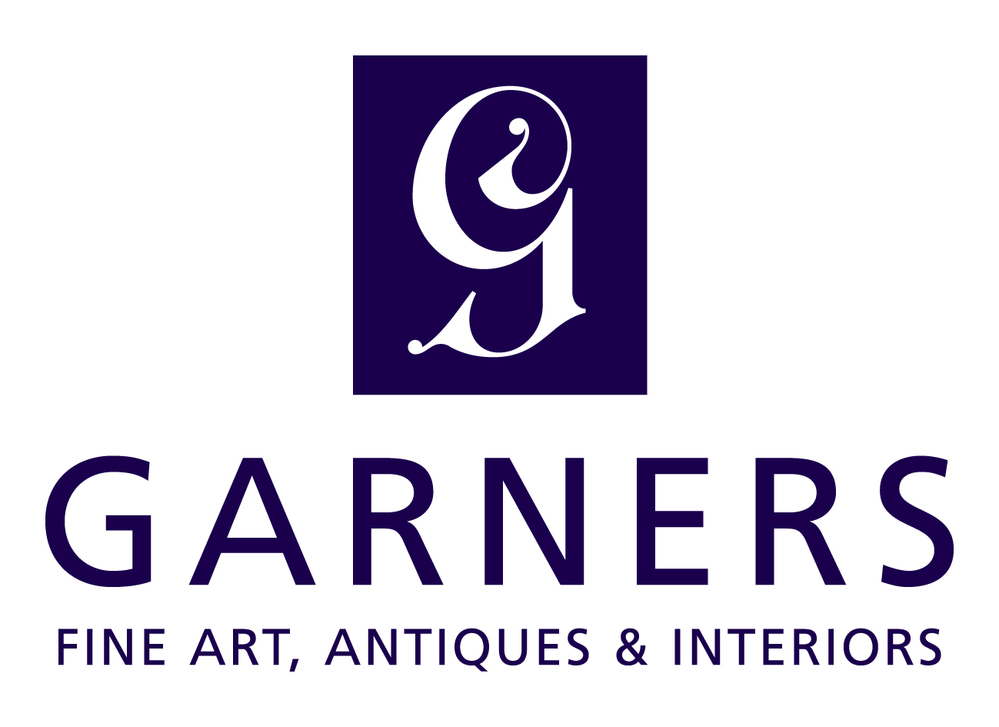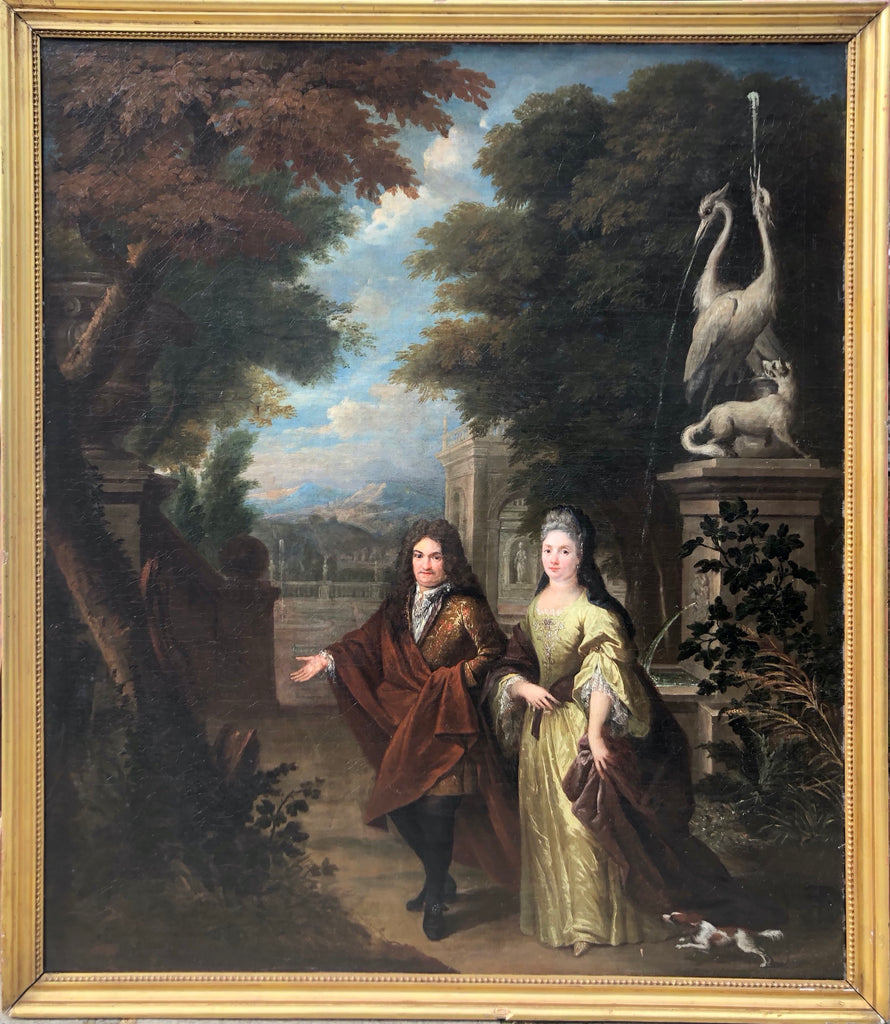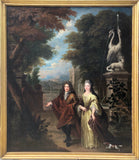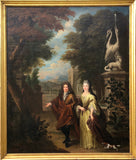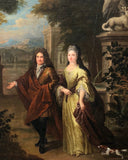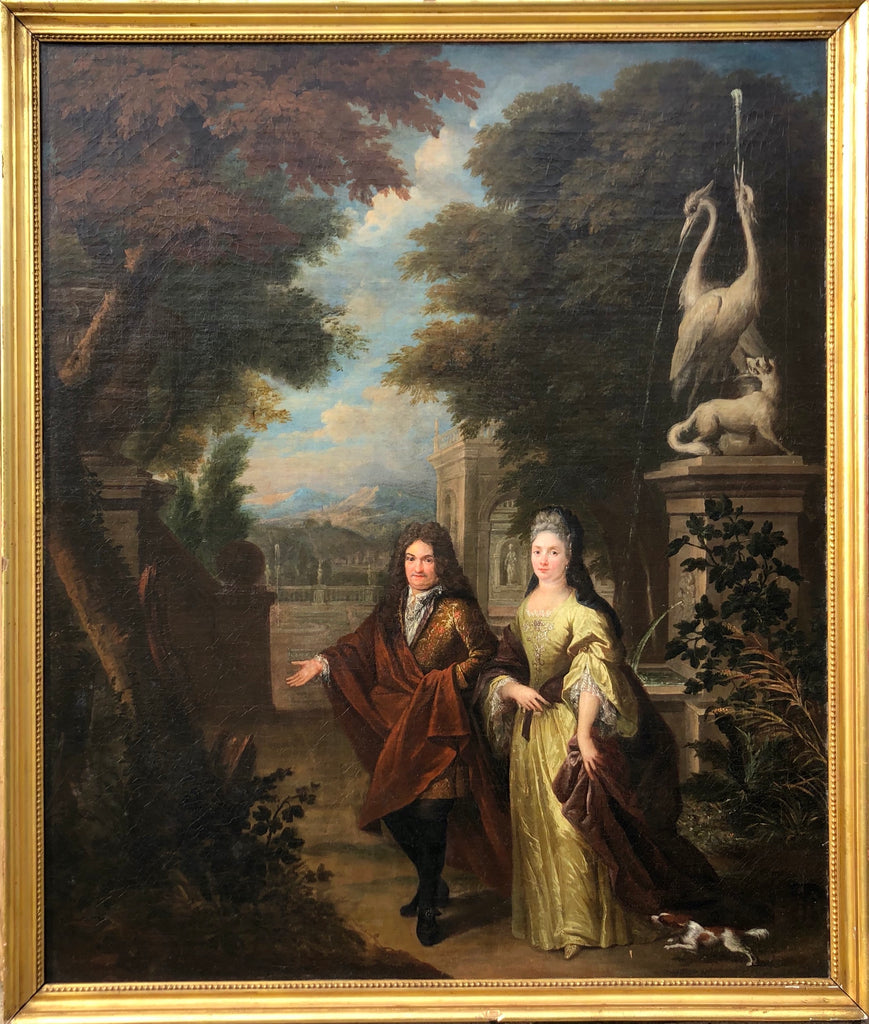See more: Oil Paintings
Portrait Oil Painting, Jan Weenix (1642-1719) Garden Scene.
£12,500.00
Portrait Oil Painting, Ornamental Garden Scene, Jan Weenix .1642 – 1719) Dutch Golden Age painter.
Portrait of Jacques van der Aa and Marie Cornélie vandenBosche.
Jacques Hyacinthe van der Aa, was married in Antwerp on 23 September 1702 to Marie Cornélie van den Bossche (widow of François de Craen).
Provenance:
Son: Abraham van der Aa (1703-1769) x Maria de Vlieger
Granddaughter: Maria Anne Van der Aa (1745-1771) x Daniel Auvray
Great granddaughter: Pétronille Auvray (1770-1835) x Jacques della Faille (1770-1846)
Great great grandson Edouard della Faille de Waerloos (1799-1870) x Julie Marie Joséphine della Faille
Great great great grandson: jonkheer Emile Augustin della Faille de Waerloos (1835-1890) and lastly to his widow Edith Marie Antoinette Constance van Eersel (1841-1921).
The couple married on 26 April 1865 in the Cathédrale Notre Dame, Antwerp. They had one child: Maurice Edouard Emile della Faille (1866-1869). Their very important collection of artworks was sold in Antwerp in 1922 after the death of Edith on 23 November 1921.
This painting was lot 24 in the above auction.
Housed in a small later gilt frame, (Larger frame can be supplied).Wax seal on reverse.
Biography:
Jan Weenix was born in Amsterdam in 1642, the son of the Italianate painter Jan Baptist Weenix (1621–1660/1661) and Josina de Hondecoeter. He spent his early childhood in Amsterdam without his father, who left for an artistic sojourn in Italy just fourteen months after Jan’s birth. Jan Baptist returned to Amsterdam in 1647, and shortly thereafter the family moved to Utrecht. By 1657 they had settled in a large house outside of the city, the “Huis ter Mey,” where the younger Jan became a pupil in his father’s studio.
After Weenix joined the Utrecht painter’s guild in 1664, he painted Italianate genre scenes in the manner of his father. He probably moved to Amsterdam in the early 1670s, although the first official record of him in that city was not until October 1679, when he married. In Amsterdam Weenix abandoned the painting of Italianate scenes in favour of extravagant game pieces, a genre that had gained popularity since the 1650s, thanks in part to Weenix the elder's success in painting such scenes. Jan Weenix had only one known pupil, Dirk Valkenburg (1675–1721), who closely imitated his master’s style.
Weenix’s paintings, which were sought after by wealthy Amsterdam burghers, typically depict dead game set against lush landscapes with dramatic views into the distance. He often combined these scenes with classical elements, including antique urns and statues. At the turn of the century, his reputation attracted the attention of Johann Wilhelm von der Pflaz, the German Elector Palatine in Düsseldorf, for whom he produced numerous game pieces and large still lifes from 1702 until about 1714
Canvas Size: 42" x 35"
Framed Size: 45" x 38"
Portrait of Jacques van der Aa and Marie Cornélie vandenBosche.
Jacques Hyacinthe van der Aa, was married in Antwerp on 23 September 1702 to Marie Cornélie van den Bossche (widow of François de Craen).
Provenance:
Son: Abraham van der Aa (1703-1769) x Maria de Vlieger
Granddaughter: Maria Anne Van der Aa (1745-1771) x Daniel Auvray
Great granddaughter: Pétronille Auvray (1770-1835) x Jacques della Faille (1770-1846)
Great great grandson Edouard della Faille de Waerloos (1799-1870) x Julie Marie Joséphine della Faille
Great great great grandson: jonkheer Emile Augustin della Faille de Waerloos (1835-1890) and lastly to his widow Edith Marie Antoinette Constance van Eersel (1841-1921).
The couple married on 26 April 1865 in the Cathédrale Notre Dame, Antwerp. They had one child: Maurice Edouard Emile della Faille (1866-1869). Their very important collection of artworks was sold in Antwerp in 1922 after the death of Edith on 23 November 1921.
This painting was lot 24 in the above auction.
Housed in a small later gilt frame, (Larger frame can be supplied).Wax seal on reverse.
Biography:
Jan Weenix was born in Amsterdam in 1642, the son of the Italianate painter Jan Baptist Weenix (1621–1660/1661) and Josina de Hondecoeter. He spent his early childhood in Amsterdam without his father, who left for an artistic sojourn in Italy just fourteen months after Jan’s birth. Jan Baptist returned to Amsterdam in 1647, and shortly thereafter the family moved to Utrecht. By 1657 they had settled in a large house outside of the city, the “Huis ter Mey,” where the younger Jan became a pupil in his father’s studio.
After Weenix joined the Utrecht painter’s guild in 1664, he painted Italianate genre scenes in the manner of his father. He probably moved to Amsterdam in the early 1670s, although the first official record of him in that city was not until October 1679, when he married. In Amsterdam Weenix abandoned the painting of Italianate scenes in favour of extravagant game pieces, a genre that had gained popularity since the 1650s, thanks in part to Weenix the elder's success in painting such scenes. Jan Weenix had only one known pupil, Dirk Valkenburg (1675–1721), who closely imitated his master’s style.
Weenix’s paintings, which were sought after by wealthy Amsterdam burghers, typically depict dead game set against lush landscapes with dramatic views into the distance. He often combined these scenes with classical elements, including antique urns and statues. At the turn of the century, his reputation attracted the attention of Johann Wilhelm von der Pflaz, the German Elector Palatine in Düsseldorf, for whom he produced numerous game pieces and large still lifes from 1702 until about 1714
Canvas Size: 42" x 35"
Framed Size: 45" x 38"
